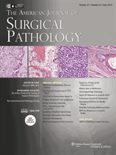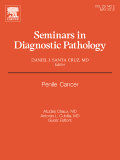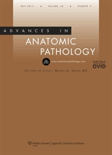
AMERICAN JOURNAL OF SURGICAL PATHOLOGY
Scope & Guideline
Advancing the Frontiers of Surgical Pathology
Introduction
Aims and Scopes
- Molecular Pathology:
Research that investigates the molecular mechanisms underlying various diseases, including cancer, with a focus on genetic alterations and their clinical implications. - Histopathological Evaluation:
Detailed studies on the histological features of tumors and other lesions, providing insights into their classification, diagnosis, and prognostic significance. - Immunohistochemistry:
Exploration of the utility of immunohistochemical markers in differentiating various neoplasms and understanding tumor behavior. - Clinical Correlation:
Investigating the relationship between pathological findings and clinical outcomes, enhancing the understanding of disease progression and treatment responses. - Emerging Tumor Entities:
Focus on newly recognized tumors and variants, including their characterization and implications for diagnosis and treatment. - Artificial Intelligence in Pathology:
Research on the application of AI technologies for enhancing diagnostic precision and efficiency in surgical pathology.
Trending and Emerging
- Genetic and Genomic Profiling:
There is a growing trend towards the use of genomic sequencing and profiling techniques to understand tumor biology and guide treatment decisions. - Tumor Microenvironment Studies:
Research is increasingly addressing the role of the tumor microenvironment in cancer progression and response to therapy, highlighting its significance in pathology. - Precision Medicine and Personalized Pathology:
Emerging focus on how molecular and genetic information can tailor treatment strategies, making pathology a critical component in the era of precision medicine. - Artificial Intelligence in Diagnostics:
The integration of AI tools into diagnostics is rapidly growing, enhancing the accuracy and efficiency of pathological evaluations. - Immune Profiling in Tumors:
Research on the immune landscape of tumors, including the role of immune checkpoints and microenvironmental factors, is becoming increasingly prominent.
Declining or Waning
- Traditional Histopathological Techniques:
There has been a shift towards molecular and genetic characterization, leading to a waning emphasis on classical histopathological techniques alone. - General Tumor Classification Systems:
As molecular profiling becomes more central, broad tumor classification systems are becoming less relevant, with a focus shifting towards specific molecular alterations. - Non-molecular Diagnostic Criteria:
Traditional diagnostic criteria that do not incorporate molecular data are being phased out in favor of more integrated approaches that consider genetic and epigenetic factors.
Similar Journals

APPLIED IMMUNOHISTOCHEMISTRY & MOLECULAR MORPHOLOGY
Advancing knowledge in histology and pathology.Applied Immunohistochemistry & Molecular Morphology, published by Lippincott Williams & Wilkins, stands as a pivotal resource within the fields of histology, medical laboratory technology, and pathology. With an ISSN of 1541-2016 and an E-ISSN of 1533-4058, this journal has been contributing significant research and advancements since its inception in 1996. It serves a diverse audience, including researchers, professionals, and students, aiming to enhance the understanding of immunohistochemical techniques and molecular morphology. Recognized for its quality, it holds category quartiles of Q3 in histology and Q2 in medical laboratory technology and pathology and forensic medicine as of 2023. The journal's rigorous peer-review process ensures that only the most impactful findings are disseminated, thus advancing the education and practice in these critical domains of study. Though it is not an open-access journal, it remains essential for keeping abreast of the latest methodological innovations and applications in pathology and laboratory science, as evidenced by its respectable Scopus rankings and the continual convergence of groundbreaking research published through 2024.

Malaysian Journal of Pathology
Fostering innovation in medical research and practice.Malaysian Journal of Pathology, published by the MALAYSIAN JOURNAL PATHOLOGY, stands as a pivotal resource in the fields of pathology and medicine, contributing rich insights since its inception in 1979. This peer-reviewed journal, based in Malaysia, is dedicated to disseminating original research, review articles, and case studies that advance the understanding of disease mechanisms and diagnostics. With a current impact factor reflecting its ranked positioning—Q4 in Cell Biology, Q4 in Histology, and Q3 in both Miscellaneous Medicine and Pathology & Forensic Medicine—this journal serves as an essential platform for researchers, clinicians, and students alike. Although it operates without open access, its scholarly rigor and contributions are well recognized, holding ranks such as #84 in Pathology and Forensic Medicine according to Scopus. The Malaysian Journal of Pathology is committed to fostering innovation and excellence in medical research, making it an invaluable tool for professionals seeking to stay abreast of significant advancements in the pathology domain.

SEMINARS IN DIAGNOSTIC PATHOLOGY
Exploring the frontiers of diagnostic pathology.Seminars in Diagnostic Pathology is a premier journal that has established itself as an essential resource in the field of pathology since its inception in 1984. Published by W B Saunders Co-Elsevier Inc, this journal boasts an impressive Q1 ranking in the pathology category for 2023, placing it in the top tier of medical journals worldwide. With a focus on diagnostic pathology, it offers a platform for groundbreaking research and advancements that bridge the gap between basic science and clinical practice. The journal is committed to publishing high-quality review articles, case reports, and expert opinions that provide valuable insights for professionals, researchers, and students alike. Although it operates on a subscription model, the journal's extensive impact is reflected in its Scopus rank (#56/208), with a remarkable 73rd percentile standing in the pathology and forensic medicine category. The journal's authoritative content not only aids in enhancing knowledge but also fosters an understanding of the evolving challenges and methodologies in diagnostic pathology, making it an indispensable tool for anyone dedicated to excellence in the field.

ADVANCES IN ANATOMIC PATHOLOGY
Empowering Researchers with Cutting-edge Findings.ADVANCES IN ANATOMIC PATHOLOGY is a leading peer-reviewed journal dedicated to the field of anatomical pathology, published by LIPPINCOTT WILLIAMS & WILKINS. With an impressive impact factor and consistent ranking in the Q1 category for both Anatomy and Pathology and Forensic Medicine, it serves as an essential resource for researchers, clinicians, and students alike. The journal has been a critical platform for disseminating significant findings and advancements in the discipline since its inception in 1996, boasting Scopus rankings of #1 in Anatomy and #11 in Pathology. While it does not provide open access, it maintains rigorous standards in the selection of articles, ensuring that published research reflects the latest developments and techniques in the field. As we look toward 2024 and beyond, ADVANCES IN ANATOMIC PATHOLOGY remains committed to advancing the science of pathology, fostering innovation, and enhancing clinical practice through impactful research.

Dermatopathology
Empowering dermatology through innovative research.Dermatopathology is a pioneering open-access journal dedicated to the field of skin pathology, published by MDPI in Basel, Switzerland. Since its inception in 2014, the journal has provided a vital platform for the dissemination of cutting-edge research, advancements, and clinical studies that aid in the understanding of dermatological diseases at the microscopic level. With its commitment to accessibility and wide-ranging contributions from international researchers, Dermatopathology serves as an essential resource for dermatologists, pathologists, and academics alike. The journal strives to foster innovative collaborations and enhance knowledge within the multidisciplinary sphere of dermatology and pathology, ensuring timely access to valuable information that can influence clinical practices and improve patient outcomes. Researchers are encouraged to submit their original articles, case reports, and reviews, contributing to the growing body of knowledge essential for advancing the field.

Turkish Journal of Pathology
Fostering Collaboration in Pathology ResearchTurkish Journal of Pathology, published by the Federation Turkish Pathology Society, stands as a vital platform for disseminating high-quality research in the field of pathology and forensic medicine. With an ISSN of 1018-5615 and an E-ISSN of 1309-5730, this journal has been an open-access publication since 2013, ensuring that cutting-edge findings are readily available to the global community. Based in Turkey, it aims to contribute significantly to the advancement of pathology as it converges from 2010 to 2024, currently holding a Q3 quartile ranking in its category according to 2023 metrics. As it ranks #129 out of 208 in the Scopus database for Medicine, Pathology, and Forensic Medicine, it offers researchers, professionals, and students invaluable insights and innovative studies that address critical developments in the field. The Turkish Journal of Pathology fosters collaboration and knowledge-sharing, making it an essential resource for anyone involved in pathology research and practice.

Journal of Clinical and Experimental Hematopathology
Empowering Researchers with Open Access Discoveries.The Journal of Clinical and Experimental Hematopathology, published by the Japanese Society of Lymphoreticular Tissue Research, is a vital resource dedicated to advancing the field of hematopathology. With an impressive Open Access model since 2019, this journal provides researchers, clinicians, and students from around the world with unfettered access to cutting-edge research and developments in hematology and pathophysiology. Based in Japan, it has established a prominent reputation in the academic community, boasting a Q3 quartile ranking in Hematology and Q1 rankings in both Medicine (Miscellaneous) and Pathophysiology as of 2023. With its innovative contributions and high visibility, the journal not only fosters scholarly discourse but also impacts clinical practices, making it an essential publication for anyone interested in the complexities of hematologic disorders. For submissions and further inquiries, the journal is located at Nagoya University Graduate School of Medicine, Japan.

INTERNATIONAL JOURNAL OF GYNECOLOGICAL PATHOLOGY
Transforming insights into gynecological care.INTERNATIONAL JOURNAL OF GYNECOLOGICAL PATHOLOGY, published by Lippincott Williams & Wilkins, is a premier academic journal dedicated to the intricate field of gynecological pathology, serving a critical role in advancing the understanding of diseases related to women's reproductive health. Since its inception in 1982, this journal has established itself as a key resource for researchers, clinicians, and students, with a current impact factor that reflects its esteemed reputation; it is ranked in the Q2 category for both Obstetrics and Gynecology, as well as Pathology and Forensic Medicine, signifying its prominence in academic circles. The journal's scope encompasses a wide array of topics, including histopathological findings, diagnostic methodologies, and evolving therapeutic strategies, all pivotal to enhancing patient care. With a steadfast commitment to disseminating high-quality research until the projected year of 2024, the INTERNATIONAL JOURNAL OF GYNECOLOGICAL PATHOLOGY is an essential read for those looking to stay abreast of the latest developments in this vital area of medical science.

International Journal of Clinical and Experimental Pathology
Unlocking the Secrets of Pathology for AllInternational Journal of Clinical and Experimental Pathology, published by E-CENTURY PUBLISHING CORP, serves as a vital resource for professionals in the field of pathology. With its ISSN 1936-2625, the journal has positioned itself within the competitive landscape of medical journals, achieving commendable rankings in Scopus, particularly in the categories of Pathology and Forensic Medicine (Rank #98/185) and Histology (Rank #38/58). Although its coverage in Scopus has been discontinued, the journal’s past contributions from 2009 to 2017 continue to be a touchstone for researchers interested in advancing their understanding of clinical and experimental pathology. The open-access format ensures accessibility to a wide audience, fostering collaboration and education in this essential medical discipline. By bridging clinical research and experimental findings, this journal plays a crucial role in disseminating knowledge and enhancing practices within pathology, making it an indispensable tool for researchers, professionals, and students alike.

PATHOLOGY & ONCOLOGY RESEARCH
Advancing the Frontiers of Cancer ResearchPATHOLOGY & ONCOLOGY RESEARCH is a prominent international journal published by FRONTIERS MEDIA SA, dedicated to advancing the fields of pathology and oncology. Operating from the Netherlands, with a distinguished address in Switzerland, this journal plays a crucial role in disseminating significant research findings and insights from 1995 to 2024. With an ISSN of 1219-4956 and E-ISSN of 1532-2807, it is indexed in well-respected databases, facilitating access to a global audience of researchers and practitioners. Notably, the journal ranks in the Q3 category for Cancer Research (2023), while being recognized in the Q2 categories for both Medicine (Miscellaneous), Oncology, and Pathology and Forensic Medicine, reflecting its authoritative status in these vital disciplines. Scopus rankings further highlight its influence, with notable percentiles across various fields. Although it follows a subscription model, the journal remains committed to publishing high-quality, peer-reviewed research that bridges conceptual gaps and encourages further exploration in oncology and diagnostic pathology, making it an indispensable resource for academics and professionals engaged in these critical areas of medicine.